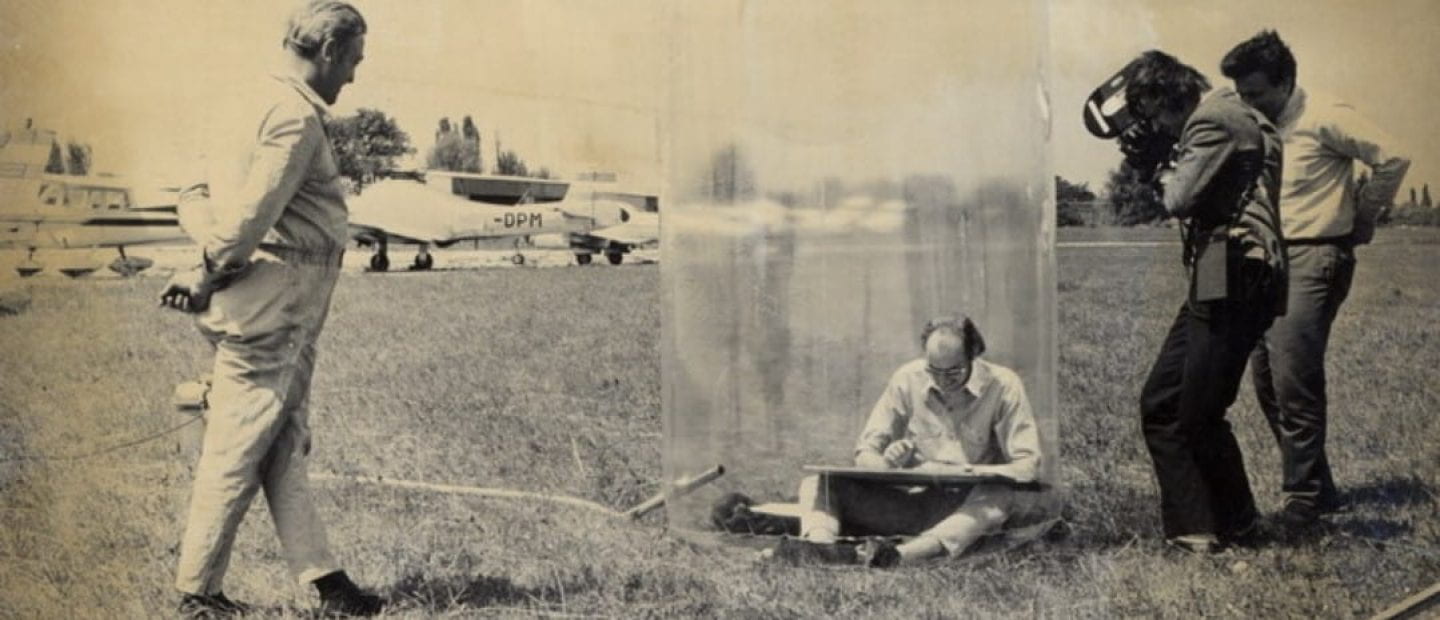Astrophobia I: H.P. Lovecraft
Astrophobia I: H.P. Lovecraft
In a 1957 essay on UFOs, Roland Barthes critiques the contemporaneous depiction of Martian civilization as “implicitly endowed with a historical determinism modeled on that of Earth […] an earth of dreams, endowed with perfect wings.”[1] For Barthes, to imagine interplanetary life is to say something about human society as well— in this instance, to domesticate the alien to the “class anthropomorphism” of petit bourgeois society.
Yet science fiction need not replicate an extant status quo. Much writing on extraterrestrial space can be read as competing visions for the future of life on earth. On the one hand, the essays and tales of writers like Alexander Bogdanov, Paul Scheerbart, and J. Posadas reveal a preoccupation with extraterrestrial life and interplanetary contact as precipitating a utopian existence on earth, one aligned with their own communist/ pacifist political leanings. To their upward gaze, the cosmos is both model and potential guide for overcoming the contradictions of capital and war. Figures like H.P. Lovecraft and Clark Ashton Smith present an alternative to this cosmophilic mode of fantasy. In their poetry and fiction they express a tendency towards astrophobia: a paranoid loathing of the stars, which are figured as receptacles for their right-wing politics of misogyny, white supremacy, and hatred of “the masses.”
Most paradigmatic is Lovecraft’s poem “Astrophobos.” The poem begins as an astral reverie: “Once I watch’d with restless yearning/ an alluring aureate star.” [2] The poetic persona’s rhapsodic gaze imagines “worlds of happiness unknown/ peace and innocence entwining/ by the Crowned Virture’s throne” upon this star. However “ o’er the vision/ crept a red delirious change/hope dissolving to derision/ beauty to distortion strange.” Suddenly, the celestial body reveals its true abnature: “cacodaemons, mir’d with madness/ through the fever’d flick’ring leer’d.” This spectacle of cosmic terror begets a generalized fear of the cosmos as such: “now I shun the spangled sable/ that I watch’d and lov’d before/ But the horror, set and stable/ haunts my soul forevermore!” From the naive cosmophile is born the jaded, knowing astrophobe.
The sense of cosmic dread is further elaborated in Lovecraft’s doggerel ars poetica “The Poe-et’s Nightmare” which recounts the hallucinatory writing process of a drunken Poe-epigone, the grocer’s clerk Lucullus Languish. The amateur poe-et proves not up to the task: “to pierce the veil/ of seeming good and seeming beauteousness/ that covers o’er the tragedy of Truth”[3] reveals instead a miasma of terrifying cosmic images. The poet is confronted with a vision of the vile universe: “far fields/ where flourish worlds invisible and vague/ fill’d with strange wisom and uncanny life […] abysmal voids/ that know the pulses of disordered force” (earlier: “and felt the mocking eyes/ of the curs’d universe upon my soul”); combined with a complementary perception of human insignificance: “that speck of dust/ whereon my form corporeal took its rise […] that fragile earth/ that crude experiment, that cosmic sport/ which holds our proud, aspiring race of mites/ and moral vermin.” This poem is striking for its fusion of atmospheric and cosmic imagery, conjuring images of galactic profusion from drifts of fog:
Whilst whirling ether bore in eddying streams
The hot, unfinish’d stuff of nascent worlds
Hither and thither through infinity
of light and darkness, strangely intermix’d
Lovecraft elaborates this atmospheric horror further in his poem “Despair.” Here, the poetic persona maps the metaphorical opposition between innocence and experience in terms of the sky: in “youth’s aspiring ember” the poet remembers “skies that now are dark were beaming.” [4] In the present, however, the “grey skies of November” signify the onslaught of disillusionment and the “deadly drowsiness of Dis.” In this poem, the sky is the privileged metaphor for the “stream of Time, swift flowing”— one in which the literal aerial space swarms with the figurative monsters of aging and death. The “evil wings” and “vultures at the spirit eating” condense into their true meaning as images of mortality: “Ghastly shares of bygone gladness/ clawing fiends of future sadness/ mingle in a cloud of madness.” Lovecraft inscribes meteorology as memento mori.
In these texts, Lovecraft expresses his misanthropy by positioning cosmic, atmospheric, and aerial imagery as sites for enmonstering and abjection. The collective dimension of this hatred brings into view Lovecraft’s reactionary politics: the otherness projected upon the cosmic void echoes his more earthbound hatred of “inferior” races and classes, “alien” cultural elements, and ultimately the fallibility and vulnerability of mortal life itself. [5] The politics of Fascism— with which Lovecraft sympathized— are implicated here: these poems articulate a disgust and terror of the embodied Other that are the dialectical reversal of the familiar somatic idealizations of Fascist aesthetics, whether in the science fictional mode of the Italian futurists, or the neoclassicism of Nazi “clean realism.”[6]
Notes:
[1] Barthes, Roland. Mythologies. Trans. Richard Howard. New York, NY: Hill & Wang. 2012. Print, p. 39
[2] Lovecraft, H.P. “Astrophobos” First published 1918. Accessed via https://www.hplovecraft.com/writings/texts/poetry/p122.aspx. Web.
[3]_________. “The Poe-et’s Nightmare” First published 1918. Accessed via https://www.hplovecraft.com/writings/texts/poetry/p085.aspx. Web.
[4] _________. “Despair” in Dreams of Fear: Poetry of Terror and the Supernatural, eds. S.T. Joshi and Steven J. Mariconda. New York, NY: Hippocampus Press. 2013. Print, pp. 307-308
[5] Poole, W. Scott. Wasteland: The Great War and the Origins of Modern Horror. Berkeley, CA: Counterpoint. 2018. Print, pp. 197-201.
[6] Ibid. pp. 167-170



Leave a Reply
You must be logged in to post a comment.